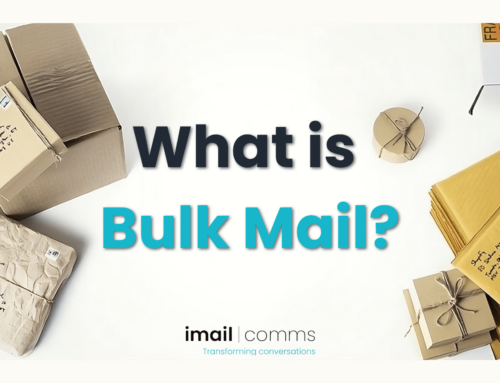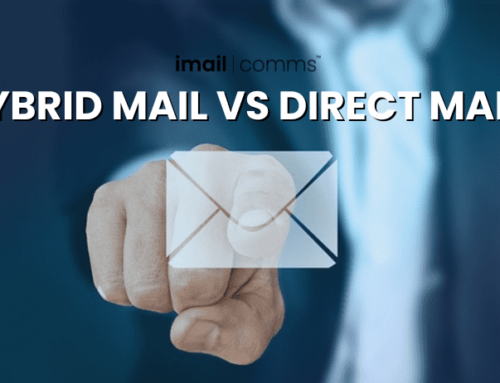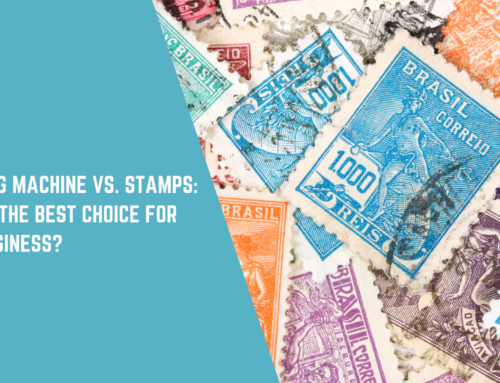Did you know that 59% of email users say they get irrelevant emails every day? The chances of your company’s email getting lost in their inbox or deleted before it’s read are very high. Consumers like to feel nurtured and have relationships with their favourite companies instead of feeling like a cog in the wheel of their marketing efforts.
Direct mail marketing hits your target audience right in their physical mailboxes. You can send out catalogues, flyers, or postcards to inform your potential customers about an upcoming sale or product launch.
This guide will go through everything from common questions like “What is direct mail marketing?” to actionable strategies for your campaign, all backed by our 15+ years of experience at imail comms.
What Is Direct Mail Marketing?
Direct mail marketing is the physical correspondence you send to current and potential customers to promote your business. The goal is to get them to purchase a product or service or come into your physical location.
Direct mailers need to include the following:
- Imagery and copy that identify your business
- A way for your customers to contact you, including your phone number, email address, and physical address
- A call to action
Does Direct Mail Still Work?
Direct mail still works—the average mail response rate for direct mail is around 9%, and approximately 87% of that segment has been driven to make an online purchase from that business.
Direct mail marketing will provide your business with more immediate responses, opening the door for additional engagement online. Your conversions and sales will increase as the targeted customers head to your website.
To print high-quality materials, you can partner with a mailing house, like imail comms. We can help you send your direct mail via Royal Mail at affordable rates.
Benefits of Direct Mail Marketing
Direct mail stands out as a powerful marketing tool, offering a personal and memorable way to connect with your audience. The advantages of direct mail marketing include:
- Interactive and Engaging
Direct mail is a tactile form of marketing that requires recipients to physically handle the piece of mail. This interaction ensures that customers will at least glance at your message before deciding whether to act on the call to action (CTA) or discard it. - Increased Retention Through Add-Ons
Including interactive elements such as QR codes, coupons, or promotional offers boosts the chances that recipients will keep and engage with the mail piece. These extras provide immediate value and encourage action. - Broader Reach Beyond Digital Channels
Direct marketing can target customers who may not be active on digital platforms or who overlook emails and online ads. This allows you to connect with a more diverse audience, expanding your reach significantly. - Less Competition in the Mailbox
With most businesses focusing on online marketing, direct mail faces less competition. This gives your message a higher chance of standing out and grabbing attention in a less crowded medium. - Highly Visible and Hard to Ignore
Most people skim through their physical advertising mail before deciding what to keep or discard. A creative and colourful direct mail piece is more likely to catch their eye and leave a lasting impression compared to similar efforts in the digital space.


Types of Direct Mail Marketing
Direct mail marketing offers a wide range of formats, each suited to specific goals and audiences. Some of the most effective types are:
- Postcards
Postcards are an affordable and straightforward option, perfect for quick announcements like sales, events, or new product launches. Their eye-catching designs and concise messaging encourages recipients to engage with them immediately. A compelling call-to-action, such as “Show this card in-store for 20% off,” can drive responses effectively. - Catalogues
Catalogues provide a comprehensive way to showcase a wide range of products, giving customers a tangible experience to explore your offerings in detail. Clear product descriptions, transparent pricing, and features like QR codes that link directly to online stores make it easy for recipients to take the next step. - Brochures and Flyers
Brochures and flyers offer the flexibility to share more about your brand or products while remaining cost-effective. With vibrant imagery, concise copy, and the inclusion of testimonials, they can build trust and generate interest effectively. - Letters
Personalised letters create a sense of exclusivity and strengthen customer relationships. Tailoring the content to the recipient’s preferences or history with your brand adds a personal touch. For instance, addressing a recipient directly and thanking them for their loyalty enhances goodwill and engagement. - Promotional Items
Including small branded items, like a pen, adds value to your direct mail and makes it memorable. Practical items that recipients use regularly help keep your business top of mind while subtly reinforcing your brand identity.
The Dos and Don’ts of Running a Direct Mail Campaign
Let’s discuss the dos and don’ts of running a successful direct mail campaign.
Do: Figure Out Who Your Audience Is
Whether you’re offering a product or service, you need to determine who your audience is. Focus your efforts on who your services and products are best suited for.
While direct mail campaigns have a high response rate and ROI, you don’t need to spend money by targeting customers who aren’t interested in what you have to offer. Spend time researching your target market.
Do: Conduct Tests
You should send out some test batches when you’ve figured out who your market is and what neighbourhoods you want to target. Send mailings to a few of your customer segments, ensuring you track your results.
For example, if you’re sending out a coupon for a product, use a unique code. Track who redeems the code on your website or at your location to determine your campaign’s effectiveness.
Do: Drive Your Traffic to Your Digital Presence
Direct mailing will likely be one aspect of your marketing efforts. Most brands will conduct the majority of their business online.
Take advantage of direct mail’s high response rate to drive recipients to your website and social media platforms. Once you’ve gotten their attention, encourage them to follow your company online so they can stay up to date with your products.
You can also link both your digital and physical marketing campaigns with some of the following strategies:
- Giveaways on social channels
- Hashtag campaigns
Don’t: Send Out Mailers With Errors
Your mail will create a lasting impression on whoever reads it. You should ensure that it’s free of grammatical errors and typos. Have multiple people read through the document to guarantee everything is correct.
If you include a coupon or QR code, double-check that it works. The last thing you want is to get potential customers to your website, only to be hit with an error code when they try to redeem your offer.
You also want to check that your copy reads well. It should hit your brand’s tone and have a good flow.
Don’t: Fail to Follow Up
As you monitor your results from your direct mail campaigns, keep track of who is and isn’t responding. You’ll have a database of engaged customers that will typically be receptive to future mailings. If specific customers aren’t engaging, you don’t need to continue to send them mailings in the future.


Creating a Mailing List for Your Direct Mail Campaign
A strong mailing list is the foundation of direct mail advertising. It’s a direct line to your ideal audience, helping you connect meaningfully and achieve measurable results.
Here’s how to build your mailing list from the ground up:
Start With Existing Customers
Start with your existing customer database. These individuals already know your brand, making them more likely to respond. Segment your list into groups, such as loyal customers, past customers, or high-value clients. Tailor your message to each group—loyal customers may appreciate VIP offers, while past customers could respond to a discount or new product announcement.
Utilise Your Website & Social Media
Encourage new sign-ups through your website and social media platforms. Offer incentives, such as discounts or exclusive access to content, to encourage visitors to join. A simple, GDPR-compliant form that collects basic details—name, email, and address—can help grow your list organically. Highlight the benefits of signing up to increase participation.
Make the Most of In-Person Interactions
In-person interactions are another valuable source of data. Collect addresses at events, trade shows, or in-store. Provide an easy way for people to share their information, such as a digital tablet or a sign-up form, and offer perks like free samples or raffle entries to boost participation.
Collaborate With Other Businesses for Wider Reach
Collaborating with complementary businesses can also help you reach a wider audience. For example, a local bakery could partner with a coffee shop to cross-promote products, sharing mailing lists (with consent) for joint campaigns.
Buy or Rent a Mailing List
Reputable companies, such as credit card companies or industry-specific databases, can supply targeted lists based on demographics, location, or purchasing behaviour. Ensure the provider complies with data privacy regulations to avoid any issues. These pre-vetted lists can help you connect with new audiences that closely match your ideal customer profile.
Keep Your Mailing List Clean
Maintaining your mailing list is just as important as building it. Regularly clean your database to remove outdated addresses, duplicates, or inactive contacts and use address validation tools to ensure your mail reaches the right recipients. After each campaign, review undeliverable mail and update your records to improve accuracy.
Fine-Tune Your Strategy
Finally, analyse your campaign results to refine your strategy. Track response rates, identify high-engagement segments, and use these insights to make future mailings more effective. For instance, you might discover that certain neighbourhoods respond better to specific offers or designs.
Direct Mail Services: Setting You Up For Success
Whether you’re looking to reach loyal customers, attract new ones, or promote a special offer, our direct mail services make it easy, efficient, and effective. We take the hassle out of direct mail, so you can create campaigns that truly stand out and deliver results.
Businesses turn to us for their campaigns because:
- We’re flexible to your needs. With us, you can scale your campaigns to fit your business, whether you’re sending one letter or thousands. It’s all about giving you the freedom to market your way.
- We’re more than a direct mail company. Our user-friendly platform lets you upload your documents, and then have them printed and posted by us—all in just a few clicks.
- We offer significant cost savings. Thanks to the volume we send through the Royal Mail network, we receive discounted rates—and we pass those savings directly on to you.
Ready to see how direct mail marketing can benefit your business? Contact us today to explore our flexible, scalable solutions tailored to your goals. Let’s make your next campaign unforgettable.
Frequently Asked Questions
We’ve gone through some of the most common questions on direct mail below.
How Does Direct Mail Work?
Direct mail speaks directly to your audience by delivering a tangible piece of marketing material, such as a postcard, brochure, or letter, to their physical mailbox. When customers receive direct mail, the goal is to get them to take action, whether it’s visiting your website or reaching out to your business.
What is an Example of a Direct Mail?
An example of direct mail is a personalised postcard promoting a local store’s opening, complete with a discount coupon. While some people might think of direct mail like this as junk mail, it’s far from it when done correctly. Effective direct mail campaigns are tailored, relevant, and provide real value to the recipient, making them a strategic and impactful marketing tool.
Is Direct Mail the Same as Email?
No, direct mail and email are not the same. Direct mail relies on the postal service to deliver physical marketing materials to recipients, while email is a digital form of communication. Postal services give direct mail the advantage of being tangible.







Leave A Comment
You must be logged in to post a comment.